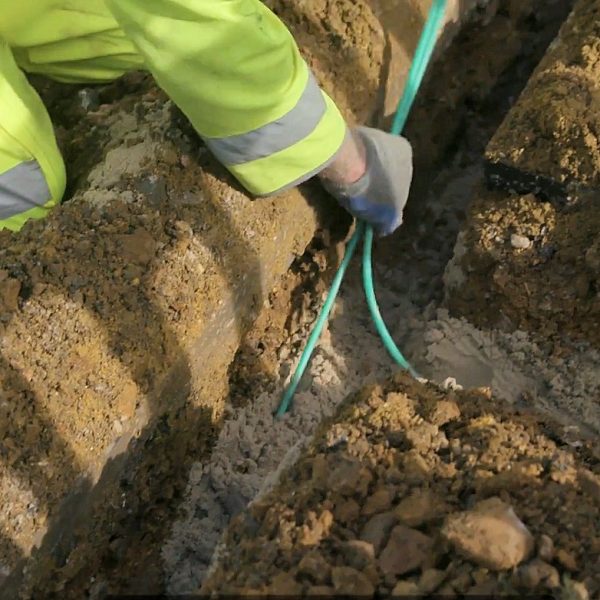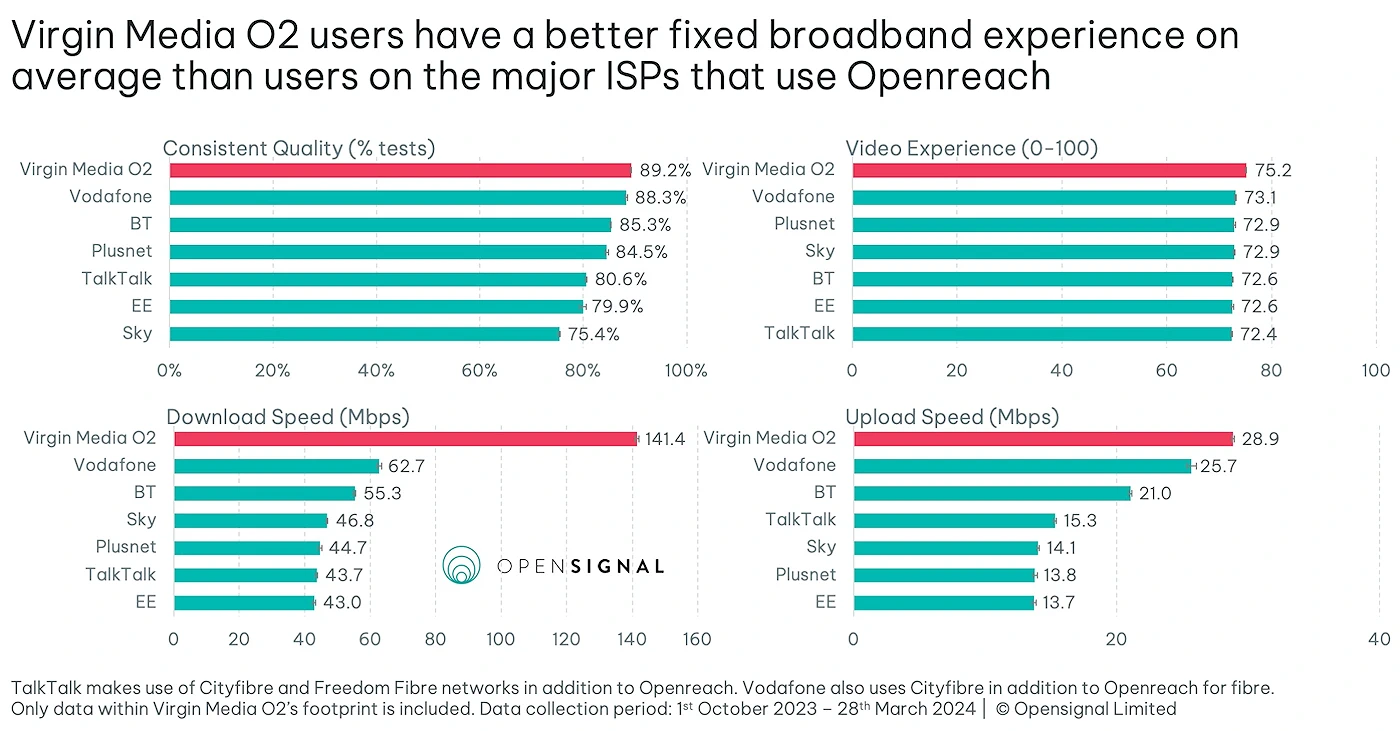Opensignal Examines the Impact of Virgin Media UK Going Wholesale

Network benchmarking firm Opensignal has published a new report that attempts to analyse the “user experience” impact of Virgin Media’s (VMO2) decision to open up their existing fixed broadband ISP network to wholesale (here) via a new business (NetCo), which is expected to be introduced during the second half of 2025.
Just to recap. Virgin Media’s existing gigabit-capable broadband network covers a shade over 16 million UK premises via a mix of different fixed line technologies, albeit primarily Hybrid Fibre Coax (HFC) and some Fibre-to-the-Premises (FTTP) lines (using both Radio Frequency over Glass (RFoG) or XGS-PON). The operator is also working to upgrade their entire HFC network (c.14.3m premises) to FTTP (XGS-PON) by 2028.
However, Virgin Media’s current network is closed, which means that only they (vertical integration) can sell broadband packages over it. Suffice to say that the recent decision to open this network up to wholesale by rival ISPs is a significant, albeit long-anticipated, development that could potentially give Openreach a major new competitor (Virgin and nexfibre combined will bring FTTP to 23 million premises or c.80% of the UK by 2028).
Advertisement
At present, it’s still far too early to judge what kind of impact this will actually have on the wider UK telecoms market, particularly since we don’t yet know anything about the kind of products, services or product flexibility they’ll be able to offer partner ISPs. Major question marks also exist over issues of cost, the scope for exclusivity agreements, and whether or not all ISPs will be treated equally and fairly by the new NetCo.
The User Experience Analysis
By comparison, Opensignal’s analysis attempts to compare the fixed broadband experience of existing VMO2 users against those users on the major Openreach tenant ISPs that aren’t owned by BT. It finds that within VMO2’s footprint, VMO2 users have, on average, a “better fixed broadband experience than those on the major ISPs that are Openreach tenants“.

However, the smaller footprint of VMO2’s network is also said to imply that “NetCo will — at least initially — only be able to compete for wholesale ISP tenants in a limited capacity, with a focus on urban and suburban areas“. This is to be expected, given Virgin Media’s pre-existing focus on urban areas, but then 16.2 million premises isn’t all that “limited“, unless they decide to initially only launch wholesale via the XGS-PON side of things to keep it aligned with nexfibre (the exact plan is still subject to some debate).
Advertisement
In addition, most Sky Broadband, TalkTalk and Virgin Media users within the latter’s footprint place within the two lowest speed brackets. This is especially pronounced for TalkTalk and Sky Broadband, with 71.4% and 66%, respectively, of Opensignal’s users’ download speeds placing in the bottom two brackets. Similarly, Virgin Media users in the slowest speed bracket also have a “more consistent experience” than those on Sky and TalkTalk.
The full report delves into all of this testing in a lot more detail, although we have significant doubts about the usefulness of this approach. This is because it’s generally unwise to try and predict future user experience by looking at Virgin Media’s own retail broadband performance, which may not be all that reflective of the services that NetCo ends up offering – wholesale is often much more complex and separate than this can reflect.
Much will admittedly depend upon the details of how NetCo actually design their wholesale proposition and how much flexibility they give to ISPs to differentiate themselves. But there can often be significant performance differences between retail and wholesale on the same physical network, which is often at least partly defined by the partner ISPs own network setup, product choices and capacity links etc.
The other difficulty for Virgin Media is that their standard retail pricing, particularly post-contract (after discounts), often comes out more expensive than many of today’s modern alternative networks. NetCo will thus need to be more competitive than that, but quite how this will be squared with the need to protect revenue and limit churn from Virgin’s retail base is as yet unclear.
Advertisement
Meanwhile, truly independent ISPs often find adopting a new network provider to be both a very complex and expensive process. Providers that make this leap also have to figure out a way of creating a streamlined set of packages for consumers, ideally without causing confusion with their existing services (i.e. too many different packages and prices make the market much harder to figure out).
Suffice to say, we’d take Opensignal’s report with a pinch of salt, since it may not be particularly reflective of NetCo’s wholesale proposition and the wider market will continue to change a fair bit by the second half of 2025.
Mark is a professional technology writer, IT consultant and computer engineer from Dorset (England), he also founded ISPreview in 1999 and enjoys analysing the latest telecoms and broadband developments. Find me on X (Twitter), Mastodon, Facebook, BlueSky, Threads.net and Linkedin.
« Gov Expanding Gigabit Broadband Vouchers to UK Urban Areas
Broadband ISP WightFibre Secures ISO 27001 Certification »





















































With VM expanding into my area, I’m just hoping for some cheaper ISPs with faster upload speeds and especially compared to VM better CS.
“unless they decide to initially only launch wholesale via the XGS-PON side of things to keep it aligned with nexfibre”
IMO that would be wise: the last thing Virgin Media’s oversubscribed, legacy HFC cable network needs is more users on it.
However, limiting the wholesale footprint makes it a lot less attractive to ISPs, so they’d better get on with the XGS-PON upgrades promptly.
Yeah. Plus, simpler product lineup to sell to retailers.
If it’s not launching for 12 to 18 months, that’s a chunk of time to improve their XGS-PON coverage.
Good. 12-18 months is more than enough time for Alt-nets to steal possible customers from them.
This is effectively all based on speeds/latency which is well known already. I don’t see how that can be credibly labelled with the catch-all term ‘user experience’?
The Ofcom complaints data suggests different anyway! Virgin Media is the most complained about broadband, landline and pay-TV provider in the country.
Yep, it’s pretty much saying that HFC is better than VDSL.
Opensignal report on speed and reliability seems way off (I guessing they are only using tests that are from vdsl only witch will make virgin look good but for reliability they are usually the worst) the video quality results are way to the same for the other providers
Virgin lacks any QOS on there network so you get good speeds (outside of peak times) at the expense of high latency and packet loss, I don’t get any of that in a vdsl or FTTP (via ONT) connection
Think a bigger issue for consumers is whether they want their garden dug up – more likely with Virgin Media than Openreach
Depends on the area once FTTP comes in openreach it have to happen (unless your in a pole)
Need openreach to get the fiber to our pole so I can leave virgin (only 30mb VDSL is available and is the only reason I am still with them as they do 500mb latency is all over the Place)
I haven’t used a real FTTPn virgin connection yet (as it like having your own dedicated FTTN node at your house so latency might be OK) but still dislike that it’s doing FTTP to docsis then back to rj45 when it should just use a fibre to rj45 ONT device
VM and their contractors don’t do very much digging – you’ll be lucky to see a spade depth trench three inches wide, and it’s as likely as not the cable will be direct buried without a conduit.
@lee they aren’t installing rfog anymore, afaik. anyone with xgspon is fttp fibre to the ont/hub.
90,350 customer reviews beg to differ
1.6 / Bad on Trustpilot
https://uk.trustpilot.com/review/www.virginmedia.com
In terms of customer experience I fear they may have somewhat lost their way since the days of VirginNet, Which?Online and ntlWorld when they consistently topped the league table each month in Internet Magazine.